17 October 2018
The exhibition of Picasso in Milan
“Metamorphosis“ from 18 October 2018 to 17 February 2019, Palazzo Reale of Milan
"If all the ways I have been along were marked on a map and joined up with a line, it might represent a minotaur."
Pablo Picasso, Minotauromachia (1935)
The exhibition 'Picasso Metamorphosis', to be held at the Palazzo Reale from 18 October to 17 February 2019, will be a central feature of the autumn season in Milan: devoted to the multifaceted and fruitful relationship the Spanish genius entertained with myth and antiquity throughout his remarkable career, it aims to explore his intense and complex creative process from this particular perspective.
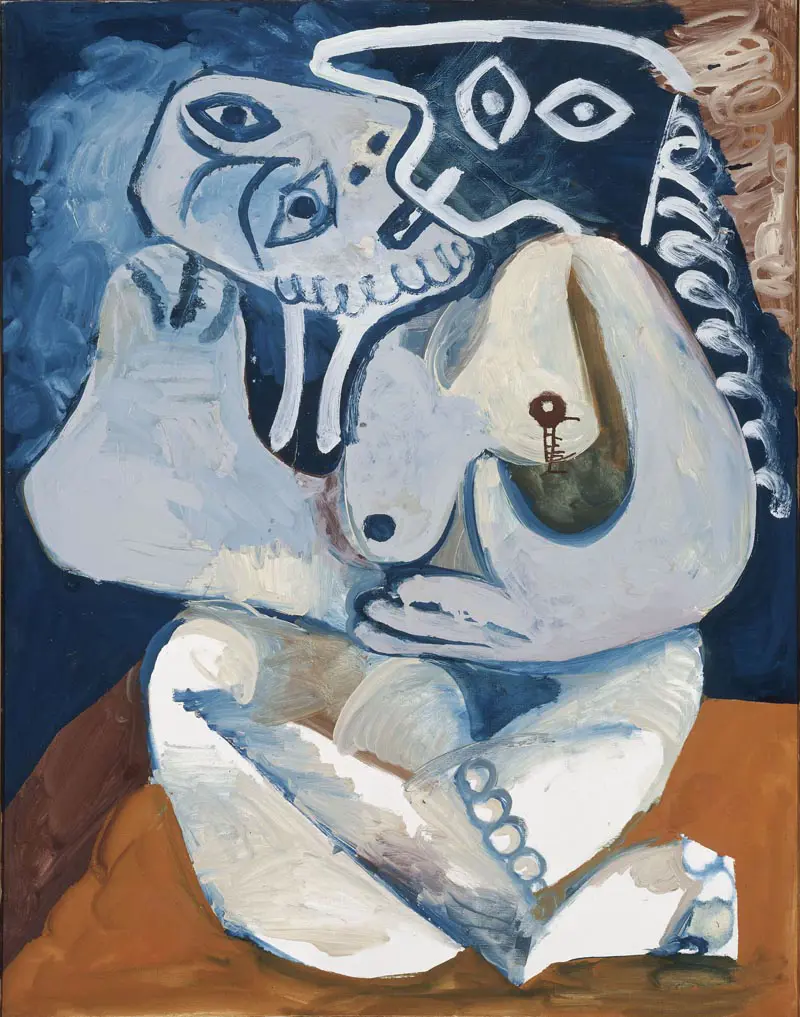
Pablo Picasso, L’abbraccio. © RMN-Grand Palais (Musée national Picasso-Paris) /Gérard Blot/ dist. Alinari
Coproduction of the exhibition by
Cultural Department of the City Council of Milan
and MondoMostre Skira.
Promoted and produced by the Cultural Department of the City Council of Milan, Palazzo Reale and MondoMostreSkira, the exhibition is curated by Pascale Picard, Director of the Civic Museums of Avignon.
The project constitutes the Milanese leg of the great triennial European exhibition 'Picasso-Méditerranée', promoted by the Picasso Museum of Paris along with other international institutions. It features around 200 displays, including both works by Picasso and ancient artworks that inspired the great master, from the Musée National Picasso in Paris and other leading European museums, such as the Musée du Louvre in Paris, the Musei Vaticani in Rome, the Museo Archeologico Nazionale in Naples, the Musée Picasso in Antibes, the Musée des Beaux-Arts in Lyon, the Centre Pompidou in Paris, the Musée de l’Orangerie in Paris, and the Museu Picasso in Barcelona.
The project is part of an itinerary devoted to the great artist that Palazzo Reale has been developing for decades: a genuine cycle of Picasso exhibitions that has made the relationship between the Spanish master and Milan a special one. It all started with the display of Guernica in the Sala delle Cariatidi (Hall of Caryatids) in 1953: a remarkable event and a genuine gift to the city from Picasso. Almost half a century later, this was followed by the grand retrospective exhibition organized, in collaboration with the artist's heirs, in September 2001, four days after the attack on the Twin Towers. Finally, the monographic exhibition of 2012 provided a chronological overview of the different techniques and means of expression marking the Spanish master's oeuvre.
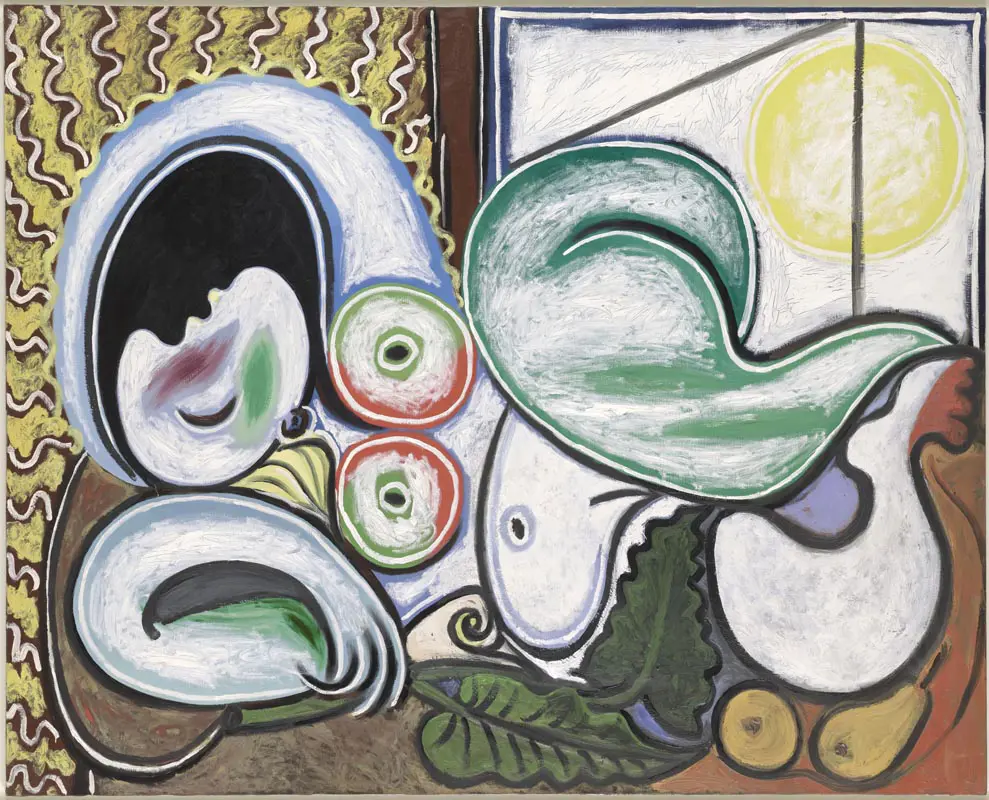
Pablo Picasso, Nudo sdraiato. © RMN-Grand Palais (Musée national Picasso-Paris) /Adrien Didierjean/ dist. Alinari.
"Metamorphosis"
With 'Picasso Metamorphosis', the focus shifts to the various expressions of antiquity to be found in the mythologies reinvented by Picasso and illustrated in the six sections of the exhibition through the juxtaposition of works by the great artist and ancient ones – pottery, statues, votive plaques, reliefs, idols, and stelae – that have inspired and deeply influenced him.
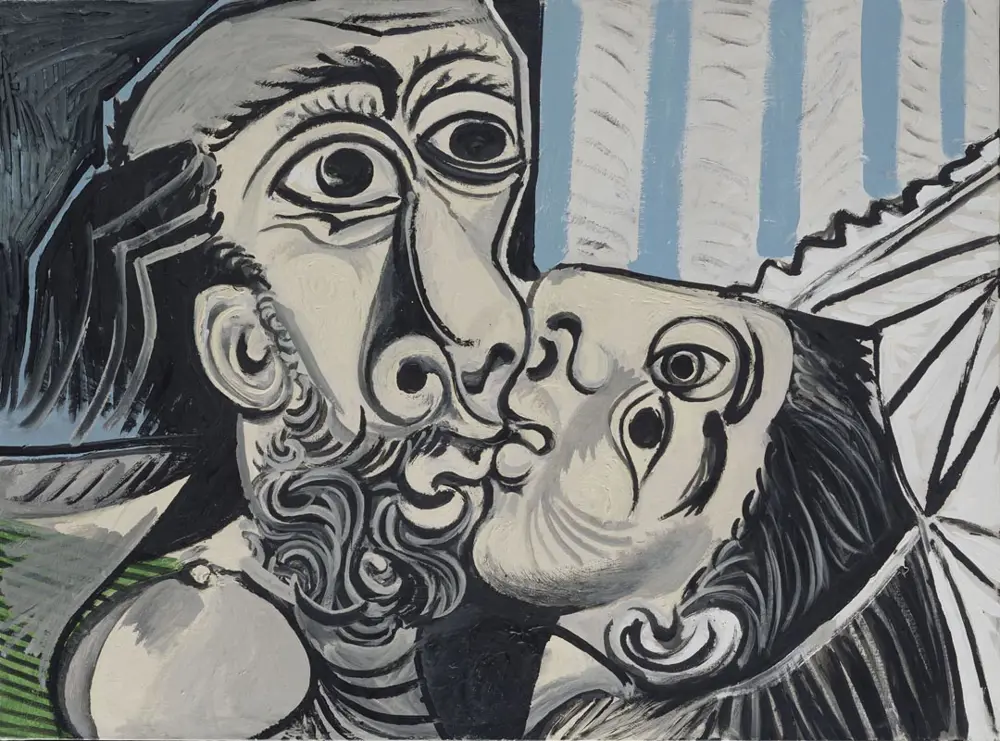
Pablo Picasso, Il bacio. © RMN-Grand Palais (Musée national Picasso-Paris) /Jean-Gilles Berizzi/ dist. Alinari.
1. The Mythology of the Kiss – Ingres, Rodin, and Picasso
With the creation of Demoiselles d’Avignon (1907), acknowledged as the manifesto of a new aesthetics, Picasso overturned the rules of academic artistic praxis. He did so by relying on his own Classical training and drawing upon the archetypes of art history, where he discovered forms suited to the metamorphosis of existing artistic codes. The way had already been paved by Ingres and Rodin before him. The introductory section of the exhibition brings together the three artists around the theme of the kiss, by juxtaposing some Picasso paintings with two emblematic works: The Kiss by Rodin and Paolo and Francesca by Ingres. This comparison shows how Picasso's approach leads to a free and profoundly innovative take on antiquity. This is illustrated by the various versions of The Kiss on display, which differ from one another and are marked by an evident erotic tension that Picasso engaged with throughout his career, from 1899 to 1970. This tension immediately highlights the fact that one of the focuses of Picasso's career was precisely his relationship with the feminine universe. Another widely explored theme is that of the artist and his models in his studio.
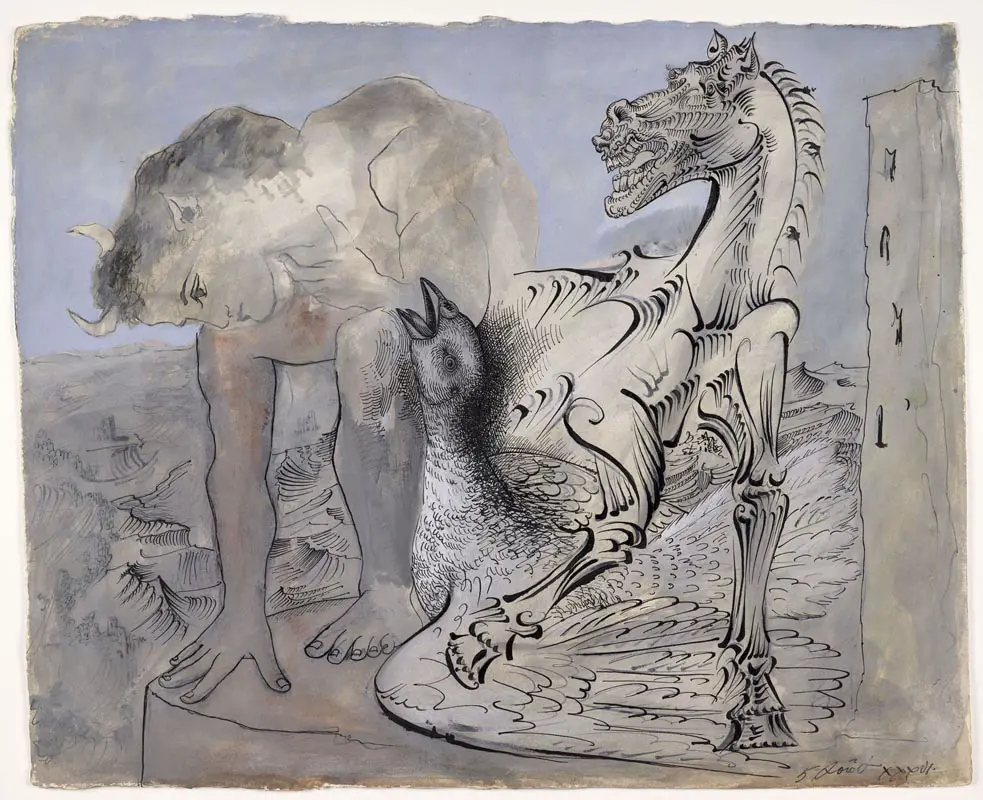
Pablo Picasso Fauno, cavallo e uccello.
© RMN-Grand Palais (Musée national Picasso-Paris) /Adrien Didierjean/ dist. Alinari.
2. Ariadne between the Minotaur and the Faun
Right from the start, in his aesthetic research Picasso looked to the many mythical portrayals of fantastic creatures. Among his recurrent points of reference we find hybrid figures torn between the human and the animal form, between good and evil, between life and death. His works are populated by male and female fauns – depicted in the pen and ink drawings Faun, Horse, and Bird (1936) and Faun (1937), and in the famous oil painting Faun's Head (1938) – but also by minotaurs and centaurs. The figure of Ariadne exemplifies beauty while also embodying renewal. At the crossroads between infidelity and idyllic love, she evokes the idea of eternal, cyclical rebirth. In Picasso's oeuvre we find many slumbering odalisques reminiscent of the famous sleeping Ariadne from the Vatican Museum. Around this figure the artist developed many themes he was particularly fond of: the minotaur, the arena, war, and the passionate love and eternal inebriation embodied by the Bacchic cortège. Ariadne's charming beauty is offered to the viewer's contemplation through a series of portrayals reflecting the feeling of love in all of its expressions: from serene eroticism to the kidnapping and rape fantasies evoked by the hybrid creatures accompanying her. Examples of this transposition are provided by the etching Pensive Boy Watching a Sleeping Girl by the Light of a Candle (1934); the pencil drawings Two Figures (1933), Woman with Arms Raised Above The Head (1939); various female nudes: the oil paintings Reclining Nude (1932) Nude with an iris bouquet and a mirror (1934); and the pen and ink drawings The Sculptor and His Model (1931), Nude Combing Her Hair (1954), and Bacchanal (1955).
3. At the Spring of Antiquity – The Louvre
From his adolescence onwards, Picasso developed his virtuosity by engaging with an academic praxis whose technique and repertoire he fully mastered, having assimilated the forms of Greek sculptures.
The artist further developed this approach through his journey to Italy in 1917, when he visited Rome and Naples, and through his encounter with Olga Khokhlova. In these years Classical inspiration attenuated Picasso's intense Cubist experience. The Spring (1921) was inspired by a personification of the River Nile from the Capitoline Museums in Rome, but also by an Ingres portrait.
In 1921 this theme evolved into Three Women at the Spring, whose subject was inspired by the depictions on a Greek vase preserved at the Louvre. Picasso, who would often visit this museum, drew inspiration from the figures in Greek bas-reliefs for his painting Seated Woman (1920), as well as for the later Nude in an Armchair (1963), the bronze Standing Man (1942), and the oil on paper Study for Man with Ram, which provides an original take on of the ancient theme, far removed from the hieratic quality of Hellenistic statues.
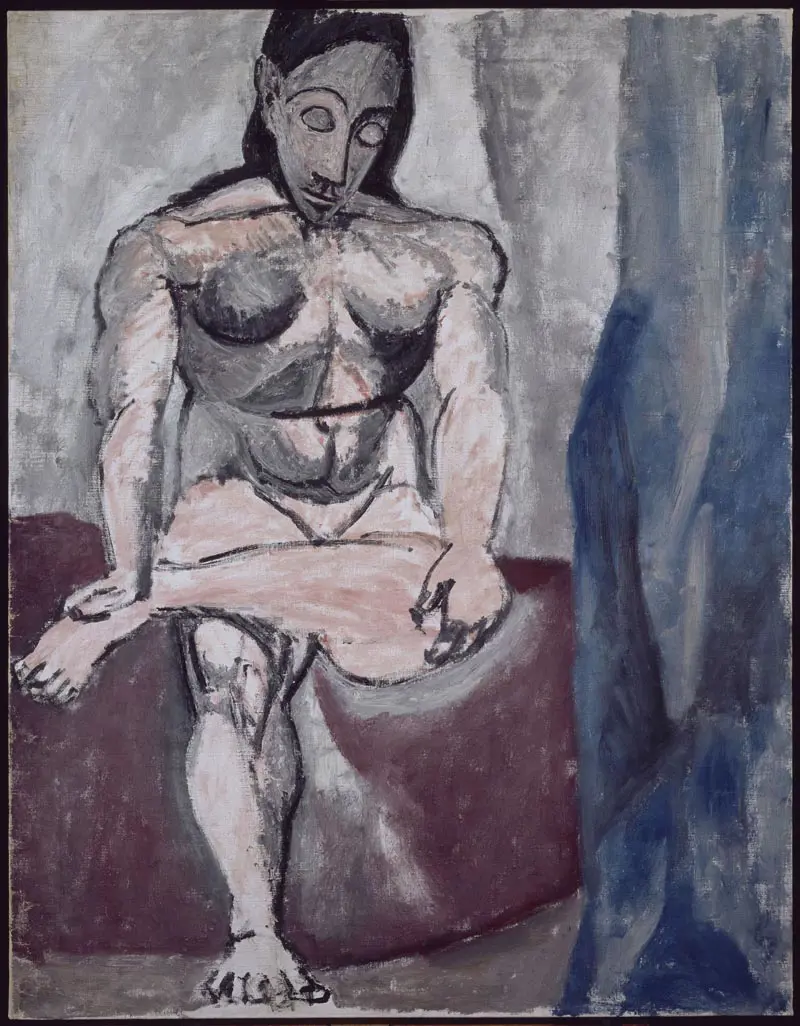
Pablo Picasso, Nudo seduto, studio per “Les demoiselles de Avignon”. © RMN-Grand Palais (Musée national Picasso-Paris) / René-Gabriel Ojéda/dist. Alinari.
4. The “Demoiselles” of the Dyplon: Greeks, Etruscans, and Iberians
Picasso regularly visited the Louvre from 1901 onwards and continued his visits even after the Second World War.
From his first partner Fernande Olivier and the writer-painter Ardengo Soffici, we know that the artist returned to the museum many times between 1901 and 1912, discovering the archaic age and the paintings on Greek vases from the geometric period, which captured his attention with their high degree of stylization.
The motifs framing these figures played a fundamental role in the process of development of Demoiselles d’Avignon, as is illustrated by the various pencil studies of nudes on display in this section, as well as by the oil paintings Seated Nude (1906-1907) and Small Seated Nude (1907), and the wooden sculptures Three Nudes (1907).
These later evolved into the wiry wooden sculptures Seated Woman and Standing Woman (1930), which foreshadow Giacometti's works, yet are inspired by Etruscan bronzes.
The influence of Cycladic Greek art pervades the magnificent Seated Nude on Green Ground (1946) and the series of bronze sculptures The Bathers (1956). Finally, Picasso drew inspiration from his extensive collection of over 90 Iberian bronze ex-votos, many examples of which are on display here for the first time.
5. The Antiquity of Metamorphoses
The spectacular sculpture Woman in the Garden (1932) – made of welded iron (a recycled material) and painted white to resemble marble – opens this section introducing Ovid's Metamorphoses.
In 1931 Picasso illustrated a famous edition of the work, which was published by Albert Skira and which Skira will be reissuing in a facsimile copy on the occasion of the present exhibition. The importance of etching in the application of Picasso's art to printing led to the creation of an art book. The limited number of copies printed and the simple lines that Picasso used to engrave the copper sheets make for a drawing-like effect. This graphic effect is also reminiscent of the ancient decorations on painted vases.
The scenes envisioned by Picasso accompany the text and highlight the importance of the literary source for the artist's interpretation of the theme. Ovid's Metamorphoses reappear in certain subjects explored in Picasso's celebrated Vollard Suite (1933-1935), some leaves of which are on display. This series presents the artist in the role of a sculptor at work on his model, evoking the myth of Pygmalion – undoubtedly one of Picasso's favourite subjects. This fascination with the appropriation of femininity sometimes leads to erotic or rape scenes reminiscent of the ancient scenes featuring fauns and Bacchants.
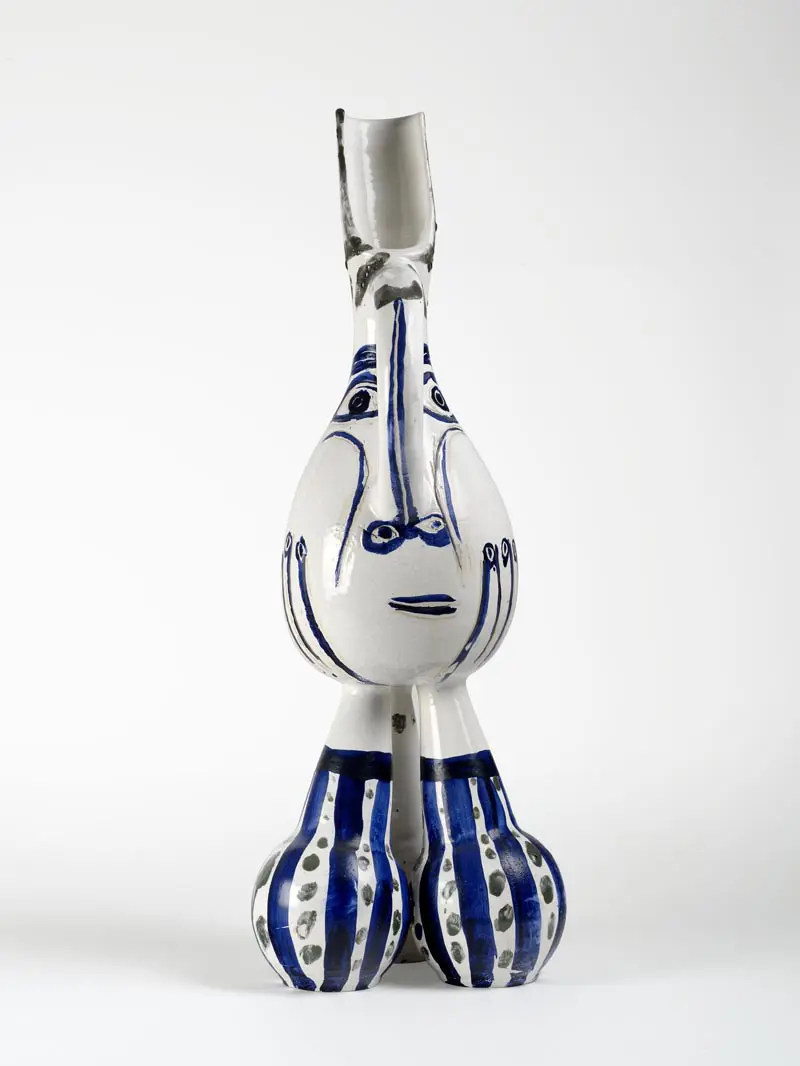
Pablo Picasso, Vaso tripode con viso di donna. © Maurice Aeschimann, 2018.
6. The Anthropology of Antiquity
Pottery is the centre focus of this sixth and last section. Picasso discovered it in the aftermath of the War, inaugurating a new chapter in the history of his borrowings from antiquity. By experimenting with the artistic potential of painted terracotta, he made objects evolve from their utilitarian function to the status of artworks.
As in antiquity, the potter and painter lived and created things together in their workshop. Potter Suzanne Ramier encouraged Picasso to explore new vase shapes and to browse archaeological repertoires.
This immersion into the ancestral universe of pottery workshops stirred the memory of Pompeii in Picasso, revealing his taste for all decorative or artistic forms of expression from the Roman world.
Picasso used various recycled materials, including fragments of cooking vessels and tiles, attaining remarkable results, as illustrated by the terracottas Vase, Woman with Mantle (1949), Vase Fragment Decorated with a Face (1950), and Seated Double-Flute Player (1958); and by the wonderful ceramics Tripod with Woman's Face (1950), Bird-Shaped Flower Vase (1950-1951), and Jug with Bull (1957).
The exhibition 'Picasso Metamorphosis', therefore, aims to delve into the intimate workshop of a world-class artist in the light of the ancient sources that have inspired his work. But it also aims to reveal the underlying mechanisms of a unique alchemy that set antiquity at the heart of modernity, and which proved crucial for 20th-century art.
Information
Milan, Palazzo Reale
Piazza del Duomo, 12, 10122 - Milan
Opening hours: Tuesday - Wednesday - Friday - Sunday: 9.30am - 7.30pm. Monday: 9.00 am - 2.00 pm - Schools. Monday: 14.30 - 19.30. Thursday and Saturday: 9.30 - 22.30. Last entry one hour before closing. www.mostrapicassomilano.it
Piazza del Duomo, 12, 10122 - Milan
Opening hours: Tuesday - Wednesday - Friday - Sunday: 9.30am - 7.30pm. Monday: 9.00 am - 2.00 pm - Schools. Monday: 14.30 - 19.30. Thursday and Saturday: 9.30 - 22.30. Last entry one hour before closing. www.mostrapicassomilano.it
Edited by Alisè Vitri
Copyright © Sisterscom.com
Source and Photo: Press Office MondoMostre Skira, Milan City Council.
All rights reserved.
You might be interested in
Destinations

Events
Italian cuisine is an Intangible Heritage of Humanity
UNESCO recognizes Italian culinary excellence worldwide, strengthening the Italian cultural identity and increasing the tourist attractiveness of the country for those who travel to discover authentic flavors
Destinations

Events
Milan will host the CAPA World Aviation Summit 2026
Top managers and international aviation players will meet in the Lombard capital to discuss sustainability, innovation and future strategies of the sector
Destinations

Events
World Tourism Day
It is celebrated on September 27 in Melaka (Malaysia) and this year's theme is "Tourism and Sustainable Transformation". It will be followed by the WTTC Global Summit in Rome from 28 to 30 September 2025


